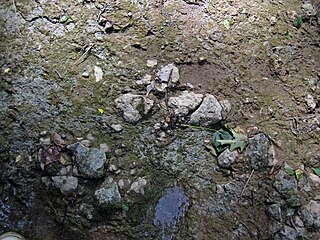
Antilocapra is a genus of antilocaprid that contains only a single living species, the pronghorn (Antilocapra americana). Another species, the Pacific pronghorn, lived in California during the Late Pleistocene and survived as recently as 12,000 BP. The name means "antelope-goat"

Megalonychidae is a group of sloths including the extinct Megalonyx. Megalonychids first appeared in the early Oligocene, about 35 million years (Ma) ago, in southern Argentina (Patagonia). There is actually one possible find dating to the Eocene, about 40 Ma ago, on Seymour Island in Antarctica. They first reached North America by island-hopping across the Central American Seaway, about 9 million years ago, prior to formation of the Isthmus of Panama about 2.7 million years ago. Some megalonychid lineages increased in size as time passed. The first species of these were small and may have been partly tree-dwelling, whereas the Pliocene species were already approximately half the size of the huge Late Pleistocene Megalonyx jeffersonii from the last ice age.

The Lucas Formation is a geologic formation in Michigan. It preserves fossils dating back to the Devonian period.

The Conemaugh Group is a geologic group in West Virginia, Pennsylvania, Ohio, and Maryland. It preserves fossils dating back to the Carboniferous period.

The Monongahela Formation is a geologic formation in West Virginia, Pennsylvania, Ohio, and Maryland. It preserves fossils dating back to the Carboniferous and Permian periods.

The Hinton Formation is a geologic formation in West Virginia. It preserves fossils dating back to the Carboniferous period. It is mainly made up of limestone, sandstone, and shale.

The Rochester Shale is a geologic formation exposed in New York and West Virginia. It preserves fossils dating back to the Silurian period.

The Whitewater Formation is a geologic formation in Ohio and Indiana. It preserves fossils dating back to the Ordovician period.

The Ohio Shale is a geologic formation in Ohio. It preserves fossils dating back to the Devonian period.

The Eau Claire Formation is a geologic formation in the north central United States. It preserves trilobite fossils from the Cambrian Period.
The Clore Formation is a geologic formation in Illinois. It preserves fossils dating back to the Carboniferous period.
The Pecatonica Formation is a geologic formation in Illinois. It preserves fossils dating back to the Ordovician period.
The St. Louis Formation is a geologic formation in Iowa. It preserves fossils dating back to the Carboniferous period.
The Blaine Formation is a geologic formation in Oklahoma. It preserves fossils dating back to the Permian period.
The Satanka Formation is a geologic formation in Wyoming. It preserves fossils dating back to the Permian period.
The Animas Formation is a geologic formation in Colorado. It preserves fossils dating back to the Paleogene period.

The Hermosa Group is a group of geologic formations in Utah and Colorado. It preserves fossils dating back to the Carboniferous period.
The Amherstburg Formation is a geologic formation in Ontario, Canada and Michigan, United States. It preserves fossils dating back to the Devonian period.
The Manitoulin Dolomite is a geologic formation in Ontario. It preserves fossils dating back to the Silurian period.
The Cabot Head Shale is a geologic formation in Michigan. It preserves fossils dating back to the Silurian period.











